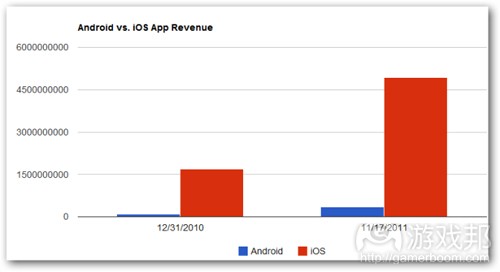分析称Piper Jaffray错估Android及iOS应用营收
作者:Todd Ogasawara
Piper Jaffray公司分析师Gene Munster最近根据苹果以及AndroLib(Android应用搜索工具)数据分析指出:
* Android Market为开发者创造的收益仅占App Store的7%;
*苹果占据整个手机应用市场85%至90%的收益;
*Android付费应用所占比例仅为1.3%,而iPhone付费应用比例达13.5%;
*苹果开发者自2011年以来已创收超过34亿美元,而Android开发者仅创收2.4亿美元;
*尽管Android智能手机市场份额增长迅速,苹果在未来三四年仍将占70%左右的手机应用收益。
不过insidemobileapps观察者却认为,该报告关于Android开发者所得收益仅占苹果开发者7%这个分析结果存在漏洞,并不能反映实际情况,主要表现在以下几个方面:
1)该报告是根据付费应用下载量计算两个平台开发者收益情况。仔细看图表中数据不难发现,这份报告所显示的两个平台总营收非常接近于付费应用平均售价、付费应用比例、应用总下载量这三者相乘的结果。
但这实际上忽略了今年的一个重要发展趋势——多数高营收应用属于免费增值产品,它们主要通过IAP模式创收。iOS前25名营收榜单中,有14款应用属于免费增值产品,而Android前25名营收榜单中,也有19款产品属于这种情况。
许多表现良好的Android开发者很早就意识到,付费应用在Android平台并不可行,因此该平台仅有一小部分开发者选择付费下载模式,而且他们也清楚这种情况。
Android与iOS两个平台付费应用表现差距较大的原因之一是,谷歌并不像苹果那样拥有2.25亿以上的信用卡支付帐户,谷歌直到最近才开始着力解决这一问题,通过最新版Android操作系统Ice Cream Sandwich要求用户输入信用卡信息。除此之外,Android用户体验和平台分裂性问题也是付费应用发展的重要阻力。
Piper Jaffray报告还忽略了开发商的广告收益。
2)该报告关于Android应用总体下载量的数据也并不正确,据谷歌第一手资料所示,Android平台在一周半以前的应用装载量就已经突破80亿次,谷歌在今年7月的财季电话会议中就已宣布Android平台应用装载量达到60亿次。
不过这份报告所反映的总体趋势属实,顶级和中型开发商普遍承认他们在Android平台创造的收益低于iOS平台。例如,Glu Mobile(游戏邦注:它有一款游戏跻身iOS营榜单前25名,有三款游戏进入Android营收榜单前25名)在最近的财季电话会议中指出,他们在Android平台创造的收益占公司智能手机业务的30%,而苹果iOS收益则占70%。
但也有一些特例,比如Storm8就曾在10月份的一次会议上声称他们在Android平台的每用户平均收益高于iOS平台,而Spacetime Studios也属于类似的情况。香港工作室Animoca(最近刚融资500万美元)也在9月份指出,他们在Android平台的每用户平均收益比iOS高30%。
从总体上来看,我们还是建议想开发付费应用或者检验创意的开发者投身iOS平台,如果是开发一款非原创性的应用或游戏,那么就要确保产品质量极其过硬,并且舍得投入足够的市场营销成本,方有望获得成功。
如果是想开发在iOS市场已经很饱合的应用或者内容,最好还是进军Android这个拥有大量发展潜力的平台,只是要记住针对不同设备或不同版本的操作系统测试游戏或应用,以免受到Android分裂性问题的困扰。(本文为游戏邦/gamerboom.com编译,拒绝任何不保留版权的转载,如需载请联系:游戏邦)
Piper Jaffray’s Estimate of Android Vs. iOS Ecosystem Revenue is Flawed
Todd Ogasawara
Piper Jaffray produced one of the first cracks from a research firm at overall revenue for developers from the iOS and Android platforms today, saying that Google’s platform has generated 7 percent of the gross revenue that Apple’s has for developers.
Specifically, Gene Munster says that Android has paid $240 million out to developers while Apple has paid out a cumulative $3.46 billion.
While it’s true that Android does trail iOS in overall revenue for developers, Piper Jaffray is omitting some key points.
1) Munster’s estimates seem to be based primarily on paid downloads. If you look at Munster’s estimates, the total gross revenue Piper Jaffray calculated for both platforms is close to the average sale price of the app multiplied by the percentage of apps that are paid and then multiplied again by the estimated number of total downloads to date.
This ignores a big trend this year. Most of the highest-grossing applications are now free-to-play and monetize primarily through the sale of in-app purchases. You can see this in the iOS charts where 14 of the top 25 grossing apps are currently free and on Android where 19 of the top 25 grossing are free as well.
Many of the best performing Android-based developers realized early on that paid apps weren’t going to work on the platform. (We reported on problems with paid apps on Android 10 months ago in January.) Hence, a much smaller percentage of developers have elected to go the paid route understanding this reality.
The big reason for the difference in performance of paid applications on Android versus iOS is that Google doesn’t have the same database of credit card information that Apple has accumulated over the years through iTunes, which now numbers more than 225 million accounts. Android, with more than 200 million device activations, only now has the momentum to build up a credit card database and is doing so by prompting users to enter in their data with the latest version of the OS, called Ice Cream Sandwich. This also comes on top of issues with user experience and fragmentation.
Piper Jaffray’s estimates also exclude advertising revenue.
2) Secondly, the report also underestimates Android’s cumulative installs to date by more than 1 billion downloads. A source with first-hand knowledge of downloads on the Android platform said a week and a half ago it had passed 8 billion cumulative installs. The company last publicly shared data on this in its second quarterly earnings call in July when it said the platform had seen 6 billion installs to date.
To be fair, the spirit of the report is true. The top-tier and mid-size developers generally concede that Android trails iOS revenue. Glu Mobile, for example, which has a respectable footprint on both platforms with one top #25 grossing app on iOS and three top #25 grossing apps on Android, said in its last quarterly earnings call that Google’s platform contributed 30 percent of the company’s smartphone revenues compared to Apple’s 70 percent.
However, there are a few outliers that we know of. Storm8 said in a panel our editor Kim-Mai Cutler moderated in October that it was seeing higher average revenue per user on Android than on iOS. Similarly, Austin’s Spacetime Studios said it’s also seeing higher revenue per user on Android’s platform. Hong Kong’s Animoca, which just raised $5 million, is a third developer that said in September that it was seeing 30 percent higher ARPU or average revenue per user on Android.
The general rule of thumb we would suggest is go to iOS if you’re doing a paid app or an experimental concept. If you’re building a game or app idea that’s already been proven, it will succeed on iOS only if you’re willing to outdo the existing competition on production value and willing to spend on marketing.
Otherwise, if you’re creating something in an area or genre that’s already saturated on iOS, go to Android where it’s still the Wild West. But be prepared to QA test the game or app against lots of different devices and versions of the OS to succeed.(source:insidemobileapps)









































 闽公网安备35020302001549号
闽公网安备35020302001549号